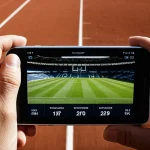Transforming Surgery: How Augmented Reality Revolutionizes Precision in Complex Procedures
The Evolution of Surgical Precision
Surgery, a field that has been at the forefront of medical innovation, is undergoing a significant transformation with the integration of augmented reality (AR) technology. This revolutionary tool is not only enhancing the precision of surgical procedures but also redefining the way surgeons train, plan, and execute complex operations.
From Traditional Methods to Augmented Reality
Traditionally, surgeons relied on 2D images and cross-sectional scans to understand the anatomy of their patients. However, these methods had limitations, particularly when dealing with complex and minimally invasive surgeries. The introduction of AR technology has bridged this gap by providing surgeons with real-time, 3D visualizations that can be overlaid onto the patient’s body during surgery.
Also read : Unleashing ai: transforming music composition and sound engineering for a new era of creativity
How Augmented Reality Enhances Surgical Precision
AR technology is transforming surgical precision in several key ways:
Real-Time Navigation
One of the most significant advantages of AR in surgery is its ability to provide real-time navigation. For instance, Philips’ ClarifEye augmented reality surgical navigation solution combines 2D and 3D visualizations with low X-ray doses, allowing surgeons to navigate through complex anatomical structures with unprecedented accuracy[3].
Improved Visualization
AR enhances visualization by projecting detailed, 3D models of the patient’s anatomy onto the surgical site. This is particularly beneficial in spine surgery, where the complexity of the spinal structure can make traditional navigation challenging. With AR, surgeons can see the exact location of nerves, blood vessels, and other critical structures in real-time, reducing the risk of complications.
Enhanced Training
AR is also revolutionizing surgical training. Platforms like Medicalholodeck offer virtual reality (VR) and AR environments where surgeons can practice and refine their skills without the risks associated with real surgeries. This includes interactive anatomy atlases, digital twins of patients, and the ability to record and replay surgical procedures for educational purposes[2].
Key Applications of Augmented Reality in Surgery
Surgical Planning
AR is significantly improving the preoperative planning phase. Surgeons can interact with digital twins of patients in VR, allowing for a comprehensive understanding of complex structures before making an incision. This enhances surgical planning and reduces the time spent in the operating room.
- **Medical Imaging XR**: Enables surgeons to visualize, edit, and discuss patient data in collaborative spaces.
- **Digital Twins**: Allows for the creation of detailed, 3D models of patients' anatomy.
- **Collaborative Teamwork**: Facilitates global collaboration among surgeons and medical teams using TeamXR[2].
Minimally Invasive Procedures
AR is particularly beneficial in minimally invasive surgeries, where the surgeon’s view is limited. By overlaying 3D images onto the surgical site, AR technology helps in identifying critical structures and navigating through tight spaces with greater precision.
- **Reduced Radiation Exposure**: AR solutions like ClarifEye minimize the need for repeated X-ray doses, reducing radiation exposure for both patients and surgeons[3].
- **Improved Accuracy**: Real-time 3D visualizations reduce the risk of complications and improve surgical outcomes.
- **Shorter Recovery Time**: Precise navigation and reduced tissue damage lead to shorter recovery times for patients[5].
Patient Education and Consent
AR is also being used to educate patients about their upcoming surgeries. By presenting medical imaging in VR, surgeons can explain pathologies, surgical approaches, and treatment plans in a way that is easy for patients to understand. This enhances patient consent and reduces anxiety.
- **Patient Understanding**: Patients can visualize their condition and the proposed surgery in 3D, improving their understanding and comfort level.
- **Informed Consent**: Detailed explanations using AR help patients make more informed decisions about their care.
- **Preoperative Preparation**: Patients can better prepare mentally and physically for their surgeries, leading to better patient outcomes[2].
Real-World Examples and Case Studies
Virtual Reality in Orthopedic Surgery
In NHS Lanarkshire, VR technology is being used to transform complex bone repairs. Surgeons are using Medicalholodeck’s VR platform to practice and refine their skills in a highly immersive environment. This has led to improved surgical precision and better patient outcomes[1].
Augmented Reality in Spine Surgery
A study published on ResearchGate highlighted the use of AR in spine surgery, demonstrating how real-time control of surgical dissectors can improve accuracy and reduce complications. The study showed that AR technology can significantly enhance the precision of surgical procedures, especially in complex spinal surgeries[5].
The Future of Augmented Reality in Healthcare
As AR technology continues to evolve, we can expect even more innovative applications in healthcare. Here are some potential future developments:
Integration with AI
The integration of AR with artificial intelligence (AI) is expected to further enhance surgical precision. AI can help in automatic segmentation of medical images, precise identification of anatomical structures, and predictive analytics for better surgical outcomes[2].
Widespread Adoption
As the cost of AR technology decreases and its benefits become more widely recognized, we can expect to see its adoption in more hospitals and medical institutions around the world.
Global Collaboration
AR will facilitate global collaboration among surgeons and medical teams, allowing for the sharing of best practices and real-time consultation during surgeries.
Practical Insights and Actionable Advice
For healthcare professionals looking to integrate AR into their practice, here are some practical insights:
Invest in Training
Investing in AR training programs can help surgeons and medical staff become proficient in using these technologies. Platforms like Medicalholodeck offer comprehensive training modules that can be integrated into existing educational curricula.
Collaborate with Tech Experts
Collaborating with technology experts can help in customizing AR solutions to meet the specific needs of your medical institution.
Patient Education
Use AR to educate patients about their surgeries. This not only improves patient understanding but also enhances patient satisfaction and outcomes.
Augmented reality is revolutionizing the field of surgery by enhancing precision, improving training, and facilitating better patient outcomes. As this technology continues to evolve, it is clear that AR will play a pivotal role in the future of healthcare, making complex surgical procedures safer, more accurate, and more efficient.
**Key Takeaways:**
- **Enhanced Precision:** AR provides real-time, 3D visualizations that improve surgical accuracy.
- **Improved Training:** AR platforms offer immersive training environments that simulate real surgical scenarios.
- **Better Patient Outcomes:** Precise navigation and reduced tissue damage lead to shorter recovery times and improved patient satisfaction.
- **Global Collaboration:** AR facilitates global collaboration among surgeons and medical teams.
- **Future Integration:** Integration with AI and other technologies will further enhance the benefits of AR in surgery.
In the words of a scholar from a study on the impact of VR anatomy training, “The use of Virtual Reality in health professions education has increased dramatically in recent years… VR anatomy instruction significantly improves the ultrasound competency of novice learners”[1].
As we move forward in this era of technological advancement, it is evident that augmented reality will continue to transform the landscape of surgery, making it more precise, more efficient, and more patient-centric than ever before.











